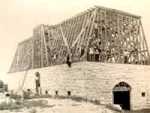Lost Nebraska...lost history

The granddaddy of the local barns had to be the stone barn that Webster Morlan built southwest of McCook. Morlan and his wife, Mary moved to McCook from Arapahoe in 1886 to become legal counsel for the Burlington and Missouri railroad. He fancied himself a rancher and grower of fruit trees so established the Morlan Ranch just south and a little west of McCook and built this stone barn and accompanying stone buildings.
Bob Clark of McCook remembers the barn and the buildings well because his grandfather, Milton Clark bought a part of the ranch around 1914 from Morlan. He bought the good part...the stone buildings and the 40 acre apple orchard.
The barn, the long narrow house, the shed which was open to the south and the 10' by 10' apple building next to the north/west county road that they called the "big road" were all known and used by Bob and his family. At one time there was a row of osage orange all around the farm with cottonwoods on the north and both boxelder and ash on the south. Clarks gave away firewood to those who needed it.
The modest stone house ran south to north and had a fireplace, a porch that ran along one side of it and it still contained the old pot bellied stove in the northwest bedroom ... up until this winter that is. This part of the property recently sold and the new owner, Randon Peters has bulldozed the house into a pile of rocks so there will be room for a new shed there.
The open shed contained the original blacksmith shop in the west one-third and machine storage in the other two-thirds. This stone building ran to within 20-30 feet of the "big road". The machine storage section was later converted into a chicken house.
This massive barn sat next to the Dry Creek to the west of the house and was open on the east and west. The hay mow above which is shown as unfinished in the photo was used for feed for the animals and to keep the bountiful crops of apples. The door on the left faced the south and was where Bob said they would take apples up to the hay mow. When the Clarks' had the farm, the barn was used for their horses, mules and a few milk cows.
The end for this marvelous barn came in about 1928-29 when lightening hit it. A ball of fire came out the east end and the whole barn was engulfed in flames. Two mules were in the barn and were killed. Bob said that his Grandpa Clark liked to use mules for the farm work. He liked them and with a few well-chosen words, could make them do what he wanted them to. He never did have a tractor.
Fred Friehe, who some of the land from Milton Clark, bought the first tractor in the neighborhood in about 1933-1934. Milton Clark and his son, Fred, raised sugar beets and would haul roughly three truckloads a day in a huge beet wagons to the beet dump by the east viaduct over the Burlington tracks. The beet wagons were pulled to town by horses before a GMC truck took over.
Each year Clarks would make two 40-50 gallon barrels of cider from the apples, then advertise in the local paper for town people to come get some free of charge. McCookites would come down the "big road" and stop at the stone apple cider building to fill their jugs. The Morlans' also built the magnificent white frame Victorian house that used to stand where the McCook Public Library does today, at Norris and H Streets. Among the luxuries that I knew it had were eight marble fireplaces, a circular carriage driveway and a dumb waiter. I'm sure it had many marvels that I never knew about. Mrs. Morlan's niece lived with her on Main Street from 1940 until May of 1944 when she passed away. The house was used as a thrift store by a local church for a number of years. The Morlan house was eventually sold by Alex Goochis and was torn down for the construction of the new library.
Any stories or additional information you might have on Webster and Mary Morlan, the beautiful ranch south of town, or Morlans' Main Street house, would be appreciated.
What a shame when architecture of this excellence is lost to natural disasters and senseless destruction.
